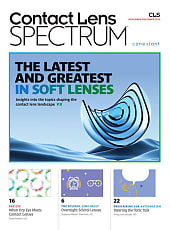A 55-year-old White fe-male with an HbA1c of 7.5 presented for her annual contact lens exam requesting new contact lenses (CL). At this appointment, she let me know she was diabetic. Additionally, she divulged her past year’s HbA1c readings had ranged from 9.5 to 7.5.
Her best-corrected visual acuity (BCVA) at this appointment was 20/30 OU. Her BCVA at her prior yearly comprehensive exam was 20/20 OU.
Dilation and optical coherence tomography revealed mild cystoid macular edema (CME) OU.
If this were your patient, how would you determine whether to bill this patient’s vision plan coverage or medical insurance? Two main factors influence this decision: Chief Complaint and Consistency. (See “Educating Patients About Their Coverage,” below.)

Chief Complaint
The patient’s chief complaint drives billing. The common chief complaints associated with diabetes are:
• Blurry vision
• Fluctuating vision
• Seeing floaters or flashes
• Difficulty seeing at night
• Eye pain or discomfort
• Routine diabetic eye screening
To discern whether diabetes may be the culprit for any of these chief complaints, practitioners can ask these pointed questions:
• What is your most recent HbA1c?
• Has your HbA1c changed in the past year?
• What medications do you use to control your diabetes? How often do you take them?
• When were you diagnosed with diabetes?
• What was your HbA1c at
diagnosis?
• When was your last examination with your primary care physician/endocrinologist?
Consistency
Each practice should be con-sistent in determining when to bill the vision plan vs the medical plan to preclude or protect against an audit. To achieve this consistency, the practice should keep a list of the vision plans and medical insurances they accept, along with their individual rules and requirements. For example, some vision plan carriers allow for a CL exam to be filed under medical insurance when a patient has diabetes, while permitting a separate refraction-only claim under the plan.
The Answer
In this case, the patient’s medical insurance was billed. This was based on protocols in our clinic and after educating the patient. For consistency, if a refraction is performed and glasses are prescribed we normally bill the patient’s vision plan.
This patient was referred to a retinal specialist regarding the CME. If a patient needs a referral, we normally educate them on this, and make sure they understand that this visit will be considered a medical visit. OM
Educating Patients About Their Coverage
Informing patients before their appointment about their medical insurance and managed vision care coverage, along with when each is typically billed and their related copays and deductibles, limits a negative patient reaction. This is because the front desk staff has managed patient expectations.
If the OD deems that the patient’s chief complaint is associated with the patient’s medical insurance vs their managed care plan, the patient should sign a document stating that they understand that their medical insurance will be used instead of their managed vision care plan. This is good record keeping and will hold up in a court of law, if you are audited.




